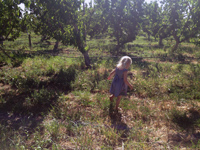
THIS WEEK’S FRUIT
Emerald Beaut Plums A freestone plum, the Emerald Beaut is a delicate green that turns golden with a hint of a blush. It has a firmer texture than the Santa Rosa with a crisp almost crunchy mouthfeel. One of our most hardy fruit, the Emerald Beaut just gets sweeter and sweeter without losing texture as it ages. Nutrition Scientists call plums a superfruit. Plums contain an antioxidant called chlorogenic acid, which may help reduce anxiety. Shinseiki Asian Pears Asian pears are also known as “apple pears” as they’re often described as having the texture and shape of the apple but with the smooth sweetness of a pear. Botanically, they’re true pears and are native to China and Japan. The Shinseiki is a medium-sized pear with smooth yellow skin. They’re nicely crisp with a sweet white flesh that’s refreshingly juicy. Pears are great sources of Vitamin C which, fights free radicals. They are also an excellent source of fiber. Eat the skins! Research shows that the skins contain three to four times as many antioxidants and anti-inflammatory flavonoids as the flesh. Doctors also recommend pears for introducing babies to solid foods because they are low in acid and will be easier on babies tummies. Warren Pears The Warren is to our pears as the Cal Red is to our peaches and the Flavor King to our pluots. This is Frog Hollow Farm’s signature pear and for good reason. Too difficult to grow for most farmers to consider it’s never caught on commercially but Farmer Al has never shied away from putting the time and effort into a fruit that tastes so good. It has a classic European texture, very soft and juicy with a silky sweetness that avoids the typical grittiness found in most pears. Pears are great sources of Vitamin C which, fights free radicals. They are also an excellent source of fiber. Eat the skins! Research shows that the skins contain three to four times as many antioxidants and anti-inflammatory flavonoids as the flesh. Doctors also recommend pears for introducing babies to solid foods because they are low in acid and will be easier on babies tummies. Flame Seedless Grapes Firm, large, and sweet the Flame Seedless are one of the most popular varieties in North America. Enjoy these out of hand or try them in green salads, chicken salads, or fruit salads. Another superfruit. Grapes are packed with a powerful antioxidant called resveratrol, which promotes a healthy heart. Muscat Grapes The Muscat family is among the oldest of grape varieties. A gorgeous green to golden blush color gives way to a perfumey and sweet flavor. These grapes have seeds but the flavor is worth the effort. Another superfruit. Grapes are packed with a powerful antioxidant called resveratrol, which promotes a healthy heart.A Note From Farmer Al
About 23 years ago when Frog Hollow Farm first went organic we came up with the name Frog Hollow Farm to evoke the connection with nature that organic farming seeks to restore. At that time, the focus was to not kill things and to let good bugs (beneficial insects) control bad bugs. With regard to soil fertility, building up organic matter with cover crops, purchased compost, sea bird guano, and seaweed products was the main focus, and all these were good strategies; they worked well. However, these methods were still materials- dependent. “Off Farm Inputs” is how they are described by the law governing organic standards. It is still farming based on the mindset of conventional and industrial agriculture, but using organic materials bought at a high cost and brought in from, often times, far away. Now, 23 years later we are learning new ways to farm which are more systems based. These methods rely on the systems of nature which already exist in the farm environment. Many can be seen with the naked eye, such as bees, bats, owls, weasels, gopher snakes, coyotes and some beneficial insects like praying mantis, lacewings and lady bugs. Many more are hidden creatures like worms or those so small as to be invisible unless seen through the lens of a microscope such as bacteria, fungi, amoeba, protozoa, nematodes and others that form the soil food web. Integrating natural systems with the not-so-natural agricultural systems of growing food for human consumption is our challenge and will take years to develop and reap benefits. When I stop and think that all life on earth evolved from a primordial ocean soup of nutrients, water and energy billions of years ago, into the complex, interactive life forms of today, I am dazzled and awed by the power of nature and thrilled by the prospect of farming with nature. Some of what we are doing is based on scientific research and historical models. For example, much is known about the behavior of animals and insects, but soil science is just now beginning to reveal the biological mysteries of the soil. So we are on new ground here, and to my knowledge farming with this developing soil science is a new frontier. The possible benefits are huge, extending even to mitigating global impacts on climate change. For us, the Frog Hollow Farm food community, the benefits will be farm sustainability, tastier more nutritious food for our families, and enhanced beauty of the farmscape.
